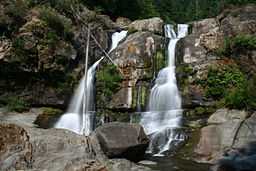South Fork Coquille River
| South Fork Coquille River | |
| River | |
 The lower tier of Coquille River Falls at low water | |
| Country | United States |
|---|---|
| State | Oregon |
| Region | Coos County |
| Tributaries | |
| - left | Johnson Creek, Salmon Creek, Dement Creek, Catching Creek |
| - right | Wooden Rock Creek, Coal Creek, Woodward Creek, Middle Fork Coquille River |
| Cities | Powers, Broadbent, Myrtle Point |
| Source | Oregon Coast Range |
| - location | Unnamed ridge, north of Mount Bolivar |
| - elevation | 3,410 ft (1,039 m) |
| - coordinates | 42°50′24″N 123°52′30″W / 42.84000°N 123.87500°W [1] |
| Mouth | Coquille River |
| - location | Myrtle Point |
| - elevation | 13 ft (4 m) |
| - coordinates | 43°04′49″N 124°08′29″W / 43.08028°N 124.14139°WCoordinates: 43°04′49″N 124°08′29″W / 43.08028°N 124.14139°W [1] |
| Length | 62.8 mi (101 km) |
| Basin | 600 sq mi (1,554 km2) |
| Discharge | for Powers, OR |
| - average | 778 cu ft/s (22 m3/s) [2] |
| - max | 48,900 cu ft/s (1,385 m3/s) |
| - min | 7.2 cu ft/s (0 m3/s) |
The South Fork Coquille River is the largest tributary of the Coquille River in coastal Oregon in the United States. From its headwaters in the Oregon Coast Range, the river flows northwest to join the North Fork Coquille River at Myrtle Point, forming the main stem Coquille. The South Fork is about 62.8 miles (101.1 km) long, and its watershed drains roughly 600 square miles (1,600 km2) of rural Coos County.
It rises as a small stream draining out of Eden Valley, 2.5 miles (4.0 km) miles northwest of Mount Bolivar in the Siskiyou National Forest. Picking up scores of tributaries, such as Wooden Rock, Clear and Panther Creeks, the river gains volume as it rumbles southwest into a deep gorge. At the confluence with Rock Creek, the river abruptly swings north, receiving Johnson Creek from the left a few miles further downstream. Now a fairly large stream, the South Fork winds through canyons to the confluence with Coal Creek before entering an alluvial valley near the small community of Powers.[3]
Below the city, the South Fork flows north through a canyon into another broad valley, now followed by Oregon Route 542, and passing Coquille Myrtle Grove State Park and Albert H. Powers Memorial State Park. About a mile downstream, Dement Creek enters from the left and the terrain around the river transforms from hills to farmland. As it assumes a meandering course, the river passes Broadbent, then the Middle Fork Coquille River, by far the largest tributary, enters from the right, marking the head of tide. A few miles onward, the river passes Myrtle Point and meets the North Fork to form the Coquille River, 36.3 miles (58.4 km) upstream of the Pacific Ocean.[3]
The South Fork Coquille River has two major waterfalls, situated in a steep and remote canyon just upstream of the first major northward bend of its course. These are the 35-foot (11 m) Upper Coquille River Falls,[4] and the much larger 110-foot (34 m) Coquille River Falls.[5]
The watershed is sparsely populated, with most of the people concentrated in the towns of Powers and Myrtle Point. Anadromous fish including salmon and steelhead inhabit much of the river, but some habitat has been compromised due to poor watershed management practices such as excessive logging and clearing.[6][7]
References
- ↑ 1.0 1.1 "South Fork Coquille River". Geographic Names Information System. United States Geological Survey. 1980-11-28. Retrieved 2011-03-18.
- ↑ "USGS Gage #14325000 on the South Fork Coquille River at Powers, OR". National Water Information System. U.S. Geological Survey. 1917-present. Retrieved 2011-03-18. Check date values in:
|date=(help) - ↑ 3.0 3.1 USGS Topo Maps for United States (Map). Cartography by United States Geological Survey. ACME Mapper. Retrieved 2011-03-18.
- ↑ "Upper Coquille River Falls". Northwest Waterfall Survey. 2008-01-12. Retrieved 2011-03-18.
- ↑ "Coquille River Falls". Northwest Waterfall Survey. 2007-09-01. Retrieved 2011-03-18.
- ↑ "Coquille River Watershed". Pacific Coast Watershed Partnership. Retrieved 2011-03-18.
- ↑ "South Fork Coquille Watershed Aquatic Restoration Plan". U.S. Forest Service. August 2007. Retrieved 2011-03-18.